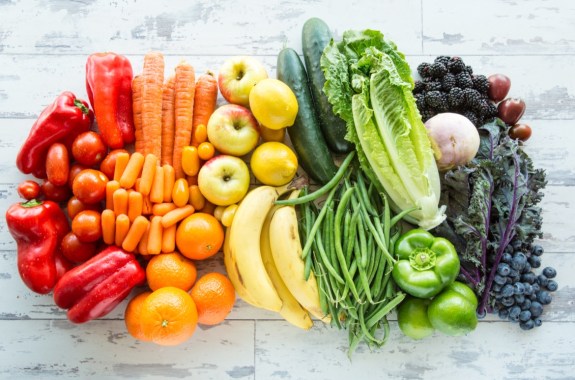Grade Level
6 - 8
minutes
60-90 minutes
subject
Life Science
Activity Type:
project-based learning, agriculture, nutrition
We have all likely been told to “eat your vegetables,” but has anyone ever suggested that you should eat the rainbow? It’s no secret that fruits and vegetables are a very important part of a healthy diet, but does it matter which fruits and vegetables you eat? Are some better for you than others? Why does it matter what colors they are?
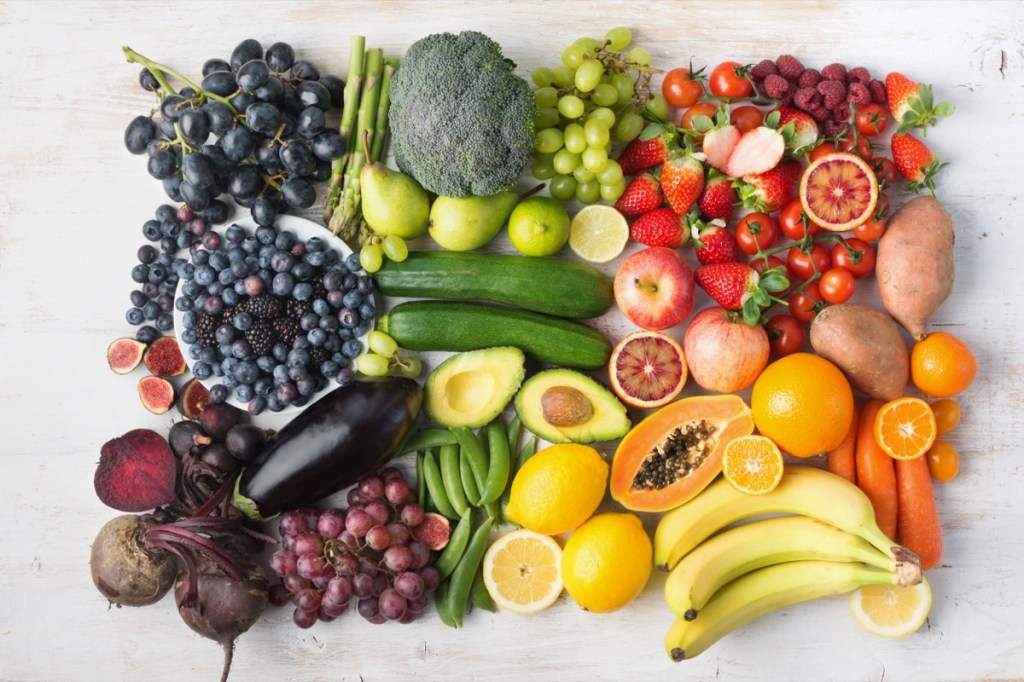
Take a look at these photos of different kinds of fruits and vegetables. What do you notice? You may have wondered where fruits and vegetables get their different colors. Many of these bright colors come from naturally occurring chemicals in plants known as phytochemicals.These are chemicals plants naturally produce, and they play an important role in protecting plants from things like bacteria, viruses, or bugs. But the different compounds also change plant color:
- Lycopenes are phytochemicals that give fruits and vegetables a red color
- Beta-carotene is present in orange foods
- Yellow and green foods contain lutein
- Anthocyanins complete the food rainbow with beautiful blues and purples
Some of these colorful plant chemicals are also important for the health of those who eat them—like us! Once consumed, some phytochemicals function as micronutrients, protecting our cells and keeping our bodies healthy.
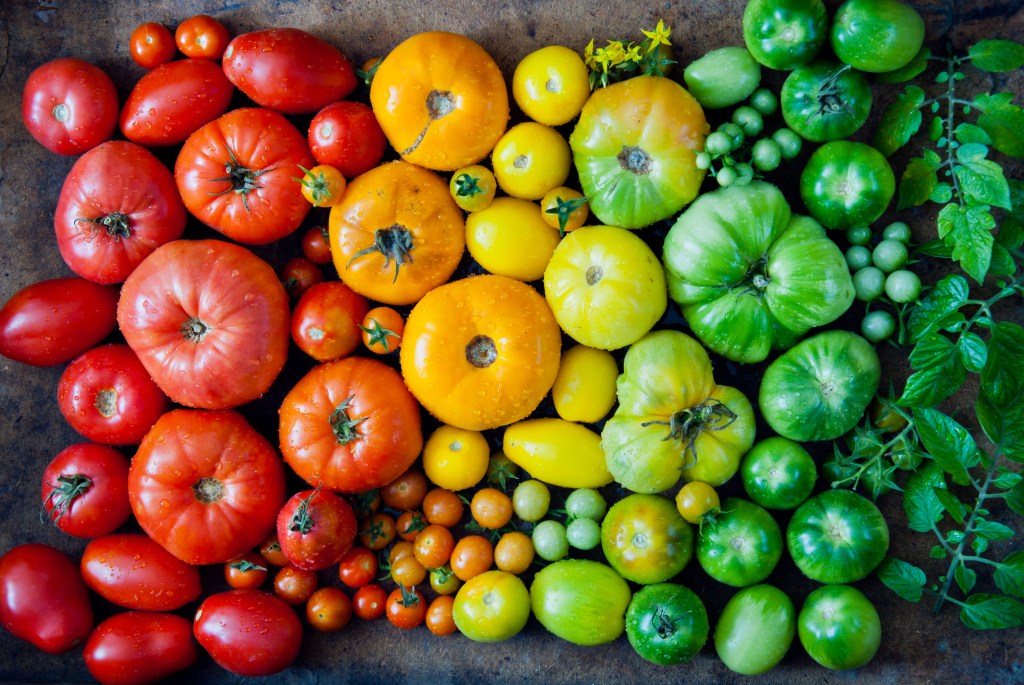
Did you notice that the photo above is made up entirely of different colors of tomatoes? Even within one type of fruit or vegetable, the amounts of different phytochemicals can vary. And some phytochemicals that double as micronutrients are not brightly colored at all. Instead, they may give the fruit or vegetable its unique odor, flavor, or another adaptive quality.
In this assignment you will explore the relationship between the various colors of fruits and vegetables, and the nutritional and health benefits they provide. Will it take more than a red apple a day to keep the doctor away?
Activity #1 - Nutrition Investigation
How can “eating the rainbow” impact our health? Start your investigation by watching this video:
Now it’s time to dig a little deeper into the micronutrients found in different fruits and vegetables. Can you connect the colors that you eat with the specific micronutrients that keep your body healthy? Choose six of your favorite fruits and/or vegetables to research online or in your local library. You can use this worksheet or create your own chart to record what you learn. Be sure to include the following information for each of your foods:
- What part of the plant (leaves, fruit, roots, seeds, etc.) is it?
- What color(s) is it?
- What are common nutrients found in this food?
- How much of each nutrient is typically found in a serving of this food
- Is there anything else that you find interesting about its colors, nutrients, and/or the health outcomes of this food?
The internet can be a tricky place to research health topics, and it is important to find reliable, accurate information—especially when you are talking about your health! Read this short article on finding reliable health information online. When in doubt, it may be helpful to ask a teacher, parent, or librarian to help you assess the quality of information or reliability of a source. Need help finding a good place to start your research? Try one of these websites:
Once you have completed your research, review your chart and reflect.
- Do you notice any patterns in your chart?
- Are there some nutrients that tend to be found in foods of specific colors?
- Could you use the color of a food to help you predict some of its nutrients? All of its nutrients?
- What connections can you make between fruit and vegetable color, nutrients, and health benefits?
- Does your research support the recommendation to “eat the rainbow”? Why or why not?
Compare your research with the information in this video. Do your conclusions match the advice in the video? Why or why not?
Dig a little deeper! Now that you have a good idea of how the colors of your foods are related to the nutrients you eat, you may be curious to learn more. Listen to this Science Friday episode that details how grocery store fruits and vegetables have lost nutrients and flavor over time, and how eating “wilder” foods can help.
What are two or three big takeaways that you learn from listening to the interview? Does it change your view of the recommendation to “eat the rainbow”? Why or why not?
Eating ‘Wilder’ Foods for a Healthier Diet
Activity #2 - Fighting Disease With A Healthy Diet
It’s one thing to learn about nutrients in our food, but that information is only helpful if we can use it. Based on the video that you watched above, your food research, and your own life experience, what illnesses or diseases do you think could be improved with a healthy diet? What fruits or vegetables would you recommend for someone living with that illness or disease?
For this activity, choose a disease or illness that affects someone you know. This could be a family member, friend, or even a pet. Use the internet or public library to learn more about this illness or disease. Find out what nutrients may have an impact on the health of the person or pet dealing with the disease. Research what foods are good sources for these nutrients. Don’t forget about spices as good sources of micronutrients, too! (All of those brightly colored leaves, seeds, and powders are thanks to phytochemicals, just like in fruits and vegetables!) Be sure to take notes on what you learn, and remember: Even though nutrition is incredibly important for getting and staying healthy, it is just one part of a healthy lifestyle that includes regular exercise, avoiding unhealthy activities and risks, and routine healthcare.
Questions to guide your research:
- Are there nutrients that could reduce the symptoms of the person or pet, and help them to live more comfortably with the disease?
- What nutrients (if any) could improve the health of the person or pet?
- Are there nutrients that could help prevent the disease or reduce the risk of the disease or illness?
- What foods contain the nutrients you would recommend for people or animals dealing with this disease?
- What foods contain the nutrients you would recommend to prevent or reduce the risk of the disease?
- Spices can be great sources of micronutrients. What spices might be beneficial to a person or animal’s health in relation to the disease you are researching?
- Is it possible to eat too much of the nutrients or foods you would recommend? How much is too much?
- What are the limitations of nutrition to reduce symptoms, prevent the disease, or treat it? Is there strong evidence that nutrition alone can do all of those things?
Be sure to use the good online research techniques that you practiced in the first activity to find accurate health information. Here are a few reliable online sources to begin your search:
- National Institutes of Health
- Mayo Clinic
- American Heart Association
- American Cancer Society
- Health Benefits of a Colorful Plate for Kids and Parents
Once you have completed your research, reflect on your findings.
- What foods or types of foods would you recommend for someone dealing with the disease or illness you researched?
- What foods or types of foods would you recommend for someone who wants to reduce their risk for the disease or illness?
- What other recommendations would you make about healthy eating habits based on your research?
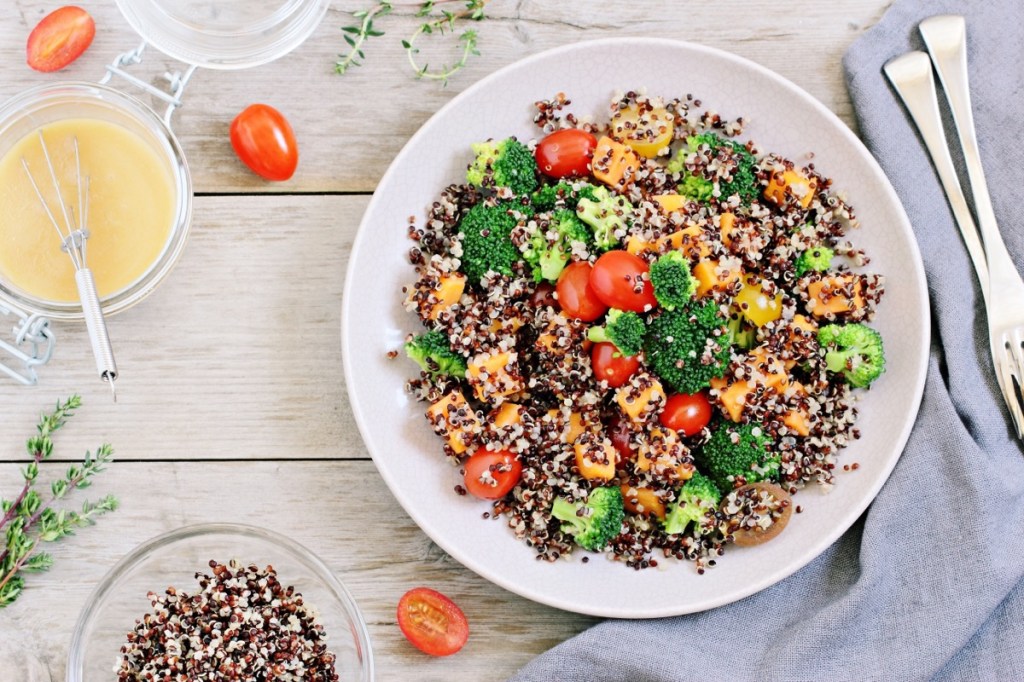
Create A Public Health Campaign
By now, you probably have a pretty good idea of how to choose healthy fruits and vegetables, especially for those who might be suffering from a specific disease or illness. Don’t keep that important information to yourself. Share it with others! Based on your research, design a public health campaign to teach others what you have learned. Choose one of the following formats: create a short video, design a poster, plan a live presentation, write and illustrate a children’s picture book, develop a simple website, or record a podcast.
Your public health campaign should include the following details:
- A clear message that shares one to three key dietary recommendations based on your research. What food(s) should people eat, and how can they identify them?
- Any cautionary messages, if relevant
– Is it unhealthy to eat too much of your recommended foods?
– Could some people have food sensitivities or allergies to them? - State what disease or illness these foods may help, but do not over-promise or make false claims.
- Provide motivation or easy steps for following the recommendations. Why should people follow your recommendations? What will make it easier for them to make healthy choices?
- Visuals should be neat, clear, and easy to read.
- Include a one-page plan for sharing your message with an audience. This plan may be in paragraph or bulleted format, and should include the following:
– Who is your audience?
– Short, written description of your campaign
– How you will share your campaign
– How your campaign will connect with a wide audience (boys and girls, different cultures, different languages, different ages, etc.) if your audience is diverse - Include a list of sources that support your key dietary recommendations.
- Develop one or two simple recipes to help your audience follow your recommendations.
Creating successful health messages for the public can be tricky. You can find advice and best practices for reaching your audience in this article of tips for effective health communication campaigns.
Once you have completed your project, find ways of spreading the word. How can you share your campaign with your class? With your school? With your community?
Extra Credit Activity: Grow a Rainbow
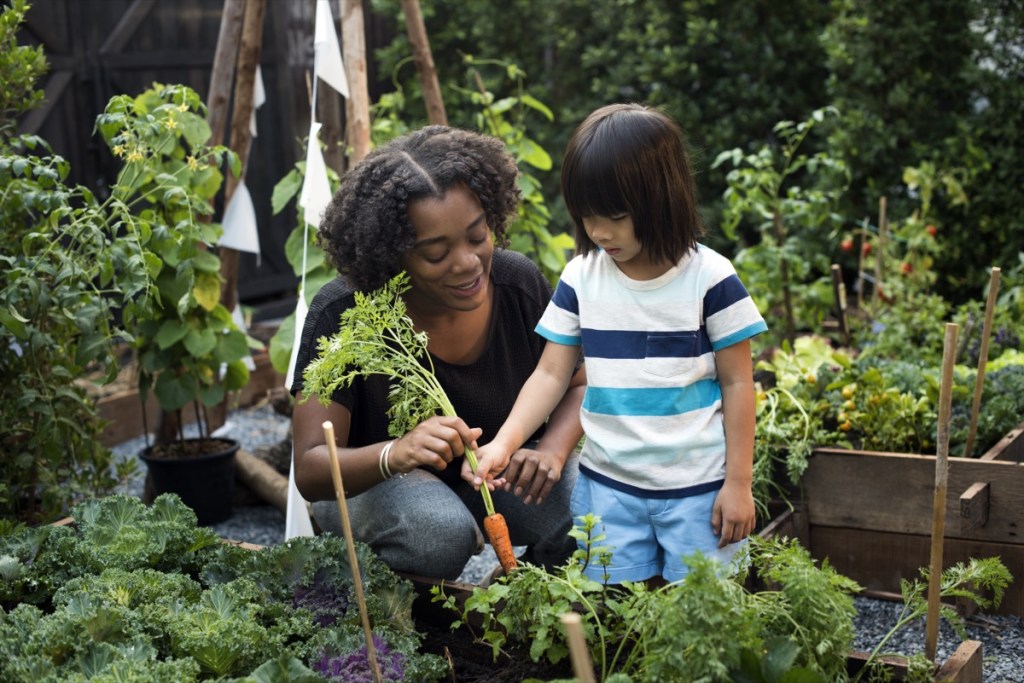
Of course you can buy fruits and vegetables at the local grocery store, but it can be a lot more fun—and very satisfying—to grow your own food. What kinds of foods would you grow to meet the dietary recommendations you made in your public health campaign? Research and purchase seeds that can grow into plants that meet one or more of those recommendations.
Questions to consider when choosing seeds:
- How much space do you have to grow your plants? A window sill? A large pot on a porch? Space in a backyard or school garden? Choose plants that will fit and flourish in the space that you have.
- What plants grow well where you live? If you will be planting outdoors, you will need to consider your elevation and how far you live from the equator. What is the typical growing season (the time after the last freeze in the spring to the first freeze in the fall)?
- Think about the climate. Do you live in a place that gets a lot of rain? Or is it an arid or semi-arid environment? What kind of soil is common in your area? It may be helpful to look for gardening information from your state’s extension office or talk to an expert at a local gardening store.
- What plants grow well inside? If you will be planting indoors, be sure to research the plants that will grow best indoors where sunlight may be less direct or space may be very limited.
- How much time do you have? Plants can vary in how quickly they grow and produce fruit. Choose an option that fits into your timeframe.
- What plants will meet the dietary recommendations from your nutrition research?
- What foods do you enjoy eating or would you like to try?
Seeds can be purchased at your local gardening store or online. Here are a few online seed resources: Harris Seeds, Gurney’s Seed and Nursery Co., Almanac.
Once you have your seeds and are ready to plant them, read the back of the seed packet for important information. You’ll need to know how deep and how far apart to plant the seeds. The packet will also indicate how much water and direct sun is recommended for your plants. You may also want to consider purchasing potting soil with or without fertilizer.
Gardening can take a little bit of trial and error and is a wonderful way to practice science skills! Do lots of background research to know the best practices for gardening in your area, but also be open to experimenting and trying new things if your plant doesn’t grow as expected. Try to remain curious and open-minded as you develop this new skill. For some Science Friday gardening advice to get you started, listen to “Want To Get Your Spring Garden Going? Here’s Some Expert Advice.”
And a word of warning: Put safety first! Gardening tools can be sharp, insects in the garden can bite and sting, and the sun can be brutal. Take safety precautions, use sunscreen, and consult with an adult about the best ways to stay healthy and safe when growing your food.
Want To Get Your Spring Garden Going? Here’s Some Expert Advice
Document your plant-growing process by making sketches and taking notes in a science journal or lab notebook. If you have a camera, take photos, as well. Write down what works and what doesn’t work. By documenting mistakes, you’ll be able to reflect and try something new the next time.
At the end of the growing season, harvest your fruit, vegetable or herbs and spices. Prepare the recipe you created and share with your family or friends. Snap a photo of your dish, your crops, or your menu and post it to social media with #EatTheRainbow.
Credits:
Lesson design: Dennis Moore
Copywriting and Educator’s Guide: Tiffany Kapler
Copyediting: Lois Parshley
Production: Ariel Zych
Educator's Toolbox
Meet the Writers
About Dennis Moore
Dennis Moore is the agricultural science teacher at Richmond Hill Middle School. Dennis builds his classes around real-world problems in which students are tasked with building solutions through project-based learning. Sustainability is a focus of his curriculum, which draws on multiple school resources including two greenhouses, a large raised bed garden, and an outdoor classroom. His students learn all about growing crops with a variety of techniques including hydroponics, aquaponics, containerized gardening, and normal soil gardening.
About Tiffany Kapler
Tiffany Kapler is an independent science education specialist. She lives for “ah-ha” moments and is passionate about sharing science as a way of exploring and understanding the world around us.
